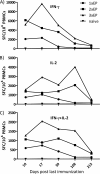Comparison of plasmid vaccine immunization schedules using intradermal in vivo electroporation
- PMID: 21752954
- PMCID: PMC3165233
- DOI: 10.1128/CVI.05045-11
Comparison of plasmid vaccine immunization schedules using intradermal in vivo electroporation
Abstract
In vivo electroporation (EP) has proven to significantly increase plasmid transfection efficiency and to augment immune responses after immunization with plasmids. In this study, we attempted to establish an immunization protocol using intradermal (i.d.) EP. BALB/c mice were immunized with a plasmid encoding HIV-1 p37Gag, either i.d. with the Derma Vax EP device, intramuscularly (i.m.) without EP, or with combinations of both. A novel FluoroSpot assay was used to evaluate the vaccine-specific cellular immune responses. The study showed that i.d. EP immunizations induced stronger immune responses than i.m. immunizations using a larger amount of DNA and that repeated i.d. EP immunizations induced stronger immune responses than i.m. priming followed by i.d. EP boosting. Two and three i.d. EP immunizations induced immune responses of similar magnitude, and a short interval between immunizations was superior to a longer interval in terms of the magnitude of cellular immune responses. The FluoroSpot assay allowed for the quantification of vaccine-specific cells secreting either gamma interferon (IFN-γ), interleukin-2 (IL-2), or both, and the sensitivity of the assay was confirmed with IFN-γ and IL-2 enzyme-linked immunosorbent spot (ELISpot) assays. The data obtained in this study can aid in the design of vaccine protocols using i.d. EP, and the results emphasize the advantages of the FluoroSpot assay over traditional ELISpot assay and intracellular staining for the detection and quantification of bifunctional vaccine-specific immune responses.
Figures





Similar articles
-
In vivo electroporation in DNA-VLP prime-boost preferentially enhances HIV-1 envelope-specific IgG2a, neutralizing antibody and CD8 T cell responses.Vaccine. 2017 Apr 11;35(16):2042-2051. doi: 10.1016/j.vaccine.2017.03.006. Epub 2017 Mar 17. Vaccine. 2017. PMID: 28318765
-
HIV-DNA Given with or without Intradermal Electroporation Is Safe and Highly Immunogenic in Healthy Swedish HIV-1 DNA/MVA Vaccinees: A Phase I Randomized Trial.PLoS One. 2015 Jun 29;10(6):e0131748. doi: 10.1371/journal.pone.0131748. eCollection 2015. PLoS One. 2015. PMID: 26121679 Free PMC article. Clinical Trial.
-
Immunization with multiple vaccine modalities induce strong HIV-specific cellular and humoral immune responses.Viral Immunol. 2012 Oct;25(5):423-32. doi: 10.1089/vim.2012.0046. Viral Immunol. 2012. PMID: 23035853 Free PMC article.
-
Electroporation delivery of DNA vaccines: prospects for success.Curr Opin Immunol. 2011 Jun;23(3):421-9. doi: 10.1016/j.coi.2011.03.008. Epub 2011 Apr 27. Curr Opin Immunol. 2011. PMID: 21530212 Free PMC article. Review.
-
The use of electroporation to deliver DNA-based vaccines.Expert Rev Vaccines. 2024 Jan-Dec;23(1):102-123. doi: 10.1080/14760584.2023.2292772. Epub 2023 Dec 18. Expert Rev Vaccines. 2024. PMID: 38063059 Review.
Cited by
-
Validation of an IFNγ/IL2 FluoroSpot assay for clinical trial monitoring.J Transl Med. 2016 Jun 14;14(1):175. doi: 10.1186/s12967-016-0932-7. J Transl Med. 2016. PMID: 27297580 Free PMC article.
-
A plant protein signal sequence improved humoral immune response to HPV prophylactic and therapeutic DNA vaccines.Hum Vaccin Immunother. 2017 Feb;13(2):271-282. doi: 10.1080/21645515.2017.1264766. Epub 2017 Jan 24. Hum Vaccin Immunother. 2017. PMID: 28118086 Free PMC article.
-
Multifarious immunotherapeutic approaches to cure HIV-1 infection.Hum Vaccin Immunother. 2015;11(9):2287-93. doi: 10.1080/21645515.2015.1021523. Hum Vaccin Immunother. 2015. PMID: 26048144 Free PMC article. Clinical Trial.
-
HIVIS-DNA or HIVISopt-DNA priming followed by CMDR vaccinia-based boosts induce both humoral and cellular murine immune responses to HIV.Heliyon. 2017 Jun 29;3(6):e00339. doi: 10.1016/j.heliyon.2017.e00339. eCollection 2017 Jun. Heliyon. 2017. PMID: 28721397 Free PMC article.
-
Novel attenuated Chikungunya vaccine candidates elicit protective immunity in C57BL/6 mice.J Virol. 2014 Mar;88(5):2858-66. doi: 10.1128/JVI.03453-13. Epub 2013 Dec 26. J Virol. 2014. PMID: 24371047 Free PMC article.
References
-
- Babiuk S., Baca-Estrada M., Babiuk L. A., Ewen C., Foldvari M. 2000. Cutaneous vaccination: the skin as an immunologically active tissue and the challenge of antigen delivery. J. Control. Release 66:199–214 - PubMed
-
- Bergman P. J., et al. 2006. Development of a xenogeneic DNA vaccine program for canine malignant melanoma at the Animal Medical Center. Vaccine 24:4582–4585 - PubMed
Publication types
MeSH terms
Substances
LinkOut - more resources
Full Text Sources
Other Literature Sources

